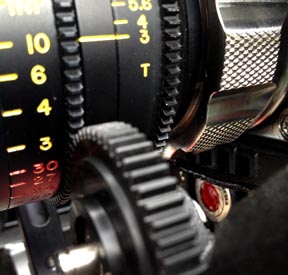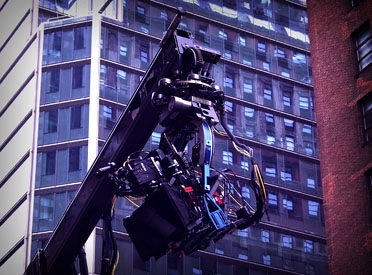








What do we do?Our Services Include:
Our president, Eric Deren was stereographer for the $80M Disney/Touchstone production of "Gnomeo and Juliet", as well as the first unit stereographer on the $240M Sony/Columbia Pictures production of "The Amazing Spiderman" coming out in 2012. Our first stereoscopic project was completed in 1999. |
|
| Stereoscopic Display Type |
Description |
Pros |
Cons |
 Polarized (linear or circular polarization) |
Two different projectors send the left-eye and right-eye images to the same screen. Projectors have light-polarizing filters placed in front of each objective lens which correspond to the filters on the inexpensive glasses the audience wears. Real-D™ offers single-projector circular-polarization systems that use a syncronized alternating filter in front of a high-end DLP projector. New polarized LCD flat screens are available, as well. | Uses inexpensive “take-away” glasses, and is very useful for large groups of people.
Most venue/ride films and feature films are displayed using this technology. Dzignlight Studios has produced media for dual-projector polarized systems, as well as for the Real-D™ single-projector circular-polarization systems. |
Specialized projector setup required, dual projector setups must be aligned correctly, and specialized silver-reflective projection screens must be used. Specialized media playback hardware is needed. |
 Shutter Glasses |
Left-eye and right-eye images are alternated rapidly on a single screen at speeds of up to 120 times per second, and the viewer wears electronic LCD glasses which are synchronized to the screen/projector and only show the left and right images to the appropriate eye. | A special screen is not always needed, although several DLP flat-screen stereoscopic display products were released in summer of 2007, targeted at consumers. Shutter-glasses are useful for small groups of people in small spaces. Projector and monitor setups are inexpensive and done with off-the-shelf hardware. |
Shutter glasses are moderately expensive, costing upwards of $80 each, and specialized media playback hardware is needed. |
 Head Mounted Display/I-glasses/Oculus Rift |
Left-eye and right eye images are displayed directly to each eye using separate screens placed in front of each eye. | Although the display technology is specialized, no specialized playback hardware is needed for interlaced systems, and media playback can be done from any consumer DVD player or other video source. | The head mounted displays are expensive, costing upwards of $400 each. Only one user can view the media at a time. Field-sequential stereo may be inappropriate for fast-moving subject material. We create media, footage, animation and VR for Oculus Rift. |
  Anaglyph (red-cyan) |
Left-eye and right-eye images are tinted red and cyan, then superimposed, and the viewer wears red and cyan glasses which filter out the opposite-colored image and display the correct image to each eye. Anaglyph can be done with almost any two significantly different colors, but the media has to be encoded specifically for each kind of glasses. ColorCode™ is another anaglyph format utilizing amber and blue lenses. Dolby Digital 3D™ is a complex version of anaglyph from Infitec™ that filters discrete wavelengths rather than a broad color range. |
Anaglyph media can be (more or less) viewed on any color display, so no specialized media playback or specialized display hardware is needed. This makes anaglyph, done correctly, the most appropriate solution for broadcast using today's technology. The glasses are very inexpensive and usually made of cardstock, which means they can be included with publications or products easily, and printed with logos or other advertisements at low cost. |
Color reproduction with classic red-cyan filters, if any, is poor. Some web compression & broadcast procedures will mangle anaglyph color values, and may induce ghosting artifacts, particularly in media with high-contrast subject matter. |
| Lenticular | A plastic sheet with small vertical lenses is aligned over a regular screen displaying horizontally-interlaced media, refracting the media so that different images are seen from different angles. Is usually presented as a "multiview" display, not just stereoscopic. Also called "autostereoscopic". |
Viewer does not need to wear glasses. Dzignlight Studios has developed media for both WOWvx™ and Alioscopy™ autostereoscopic display systems. |
Requires specialized display hardware. Has several to many zones in the viewing area where the stereoscopic effect is lost, unless more specialized hardware is used to track the primary viewer's eyes and present the stereo image correctly to that viewer's location. |
| Side-by-Side | This is a manual version of a head-mounted display. The left-eye and right-eye images are displayed side by side. The viewer aligns the images one over the other manually by either crossing or relaxing his/her eyes. | Viewer does not need to wear glasses, although some ancient lens systems were developed to simplify the problem of manually aligning the images. | Most viewers do not have the patience for this kind of stereoscopic display, and some find it extremely difficult to achieve satisfactory results. |